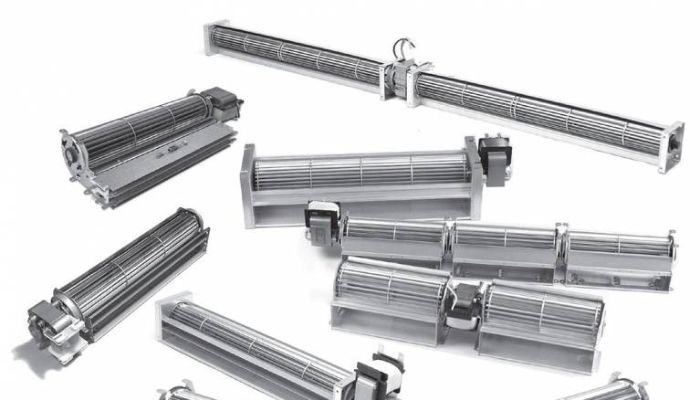Cross-flow fans are a basic part of different cooling and ventilation frameworks. These fans are famous for their interesting designs, which empower them to give uniform airflow streams across their whole length. Unlike other fan types that pass air pivotally or radially, cross fans move air oppositely to the impeller, making a wide and consistent air stream.
This makes them particularly useful in HVAC systems, air curtains, and electronic equipment cooling applications where even air distribution is essential. In this guide, we will investigate all you want to realize about cross-flow fans, including their design, working standards, applications, benefits, and hindrances.
Table of Contents
ToggleWhat Is a Cross Flow Fan?

A cross flow fan has other names like a transverse or tangential fan. Which is a kind of fan described by its barrel-shaped impeller with forward-bended blades. Dissimilar to different fans that move air pivotally or radially, cross fans direct air across the impeller and out the contrary side, coming about in a “cross” progression of air.
Design and Structure of Cross Flow Fan
Cylindrical Impeller:
So, the focal part of a cross flow fan is its tube-shaped impeller, which is outfitted with forward-bended sharp edges.
Air Entry and Exit:
So, air enters the fan from one side of the impeller. And gets across the length of the cutting edges or blades, and exits on the opposite side.
Housings:
Plus, the fan is encased in a housing that helps guide and direct the air current effectively.
Operating Principle & How Does Cross Flow Fan Work
So, these fans include a tube-shaped impeller with forward-bended cutting edges. Air enters the fan, goes along the boundary of the impeller. And ways out on the contrary side. Thus the wind current moves in a “cross” heading, giving the fan its name. Plus, cross flow fans are ideal for cooling and ventilation tasks where uniform airflow is essential due to their clever design, ensuring an even air spread.
Common Applications of Cross Flow Fan
In what applications are cross flow fans commonly used? Due to their distinctive design and effective operation, cross flow fans can be used in various contexts. So, common applications include:
1. HVAC Systems
Cross flow fans are widely utilized in warming, ventilation. And cooling frameworks to guarantee uniform air conveyance. Which is vital for keeping up with predictable temperatures and comfort levels in private, business, and modern structures.
2. Air Curtains
Cross-flow fans are widely used in air curtains to create an invisible air barrier across doorways. And this helps to keep up with indoor temperature. By forestalling the trading of air with the external climate. Further developing energy productivity and solace.
3. Electronic Equipment Cooling
Also, cooling electronic components and devices like servers, computers, and other sensitive equipment use these fans to cool themselves. As their capacity to give uniform airflow assists in proper heat dissemination. Which enhancing electronic frameworks’ life expectancy and dependability.
4. Home Appliances
Further, cross flow fans are found in domestic devices like air purifiers, broilers, and microwaves. Because, their compact design and proficient airflow make them reasonable for working on the performance and effectiveness of these machines.
5. Industrial Machinery
Moreover, in modern settings, cross flow fans cool apparatus and hardware. As, their hearty design and high capacity give reliable airflow assistance in keeping up with ideal working temperatures. That improving modern machines’ productivity and life span.
6. Automotive Climate Control
Besides, cross flow fans are utilized in automobiles’ heating and cooling systems. Where it ensures an even air distribution throughout the vehicle’s cabin and improve passenger comfort.
7. Medical Equipment
Also, in clinical gadgets and gear, cross flow fans give dependable cooling arrangements. Which guaranteeing that the gadgets work inside safe temperature ranges, which is basic for their precision and life span.
Advantages of Cross Flow Fan
What are the advantages of using a cross flow fan? Here are some popular advantages of cross flow fans.
Uniform Air Distribution
Cross flow fans ensure even cooling or heating by providing a consistent stream of air along the entire length of the outlet.
Compact Design
These fans are mostly thin and can squeeze into restricted spaces, making them ideal for applications with restricted room.
Low Noise Levels
The special design and proficient activity bring about calmer execution, contrasted with different sorts of fans.
Versatility
Cross flow fans are utilized in various applications, including electronic cooling, industrial machinery, HVAC systems, and air conditioning units.
Considerations Before Selecting Cross Flow Fan
1. Size
– Impeller Diameter: The diameter of the impeller directly impacts the volume of air produced by the fan. Bigger impeller widths regularly produce more noteworthy airflow, which is reasonable for situations requiring broad ventilation.
– Outlet Size: The size of the outlet affects the area and speed at which the fan blows air. Choose the right size to ensure adequate air circulation based on the installation space and ventilation requirements.
– Impeller fan length: Length mostly associated with the fan’s result power and model. A proper length adds to giving more steady airflow and gaseous tension, taking into account establishment space and execution needs.
– Client’s general installation space size: Consider the genuine establishment space, guaranteeing the fan’s size agrees with spatial necessities for legitimate establishment and use.
2. Parameters
- Speed: Speed impacts the fan’s airflow and pneumatic force. Proper speed can meet the ventilation needs of the framework, choosing appropriate speed rates in light of explicit situations.
- Voltage: Select a voltage specification appropriate for the fan based on the power equipment and requirements already in place.
- Airflow and Pneumatic Stress: Adjust to the prerequisites of the ventilation framework. Select appropriate airflow and air pressure parameters based on actual scenarios to ensure efficient ventilation.
- Noise and Protection Level Prerequisites: Choose fans that meet the necessary safety and comfort requirements based on the noise and protection levels required by the installation environment.
3. Accessories
Speed Regulator: Changes the fan’s speed and airflow, adjusting to various working situations and upgrading the fan’s adaptability and productivity.
Other Requirements: Terminals, warming components, warm defenders, power switches, and controls: The fan’s stability and safety are ensured by these components, which improve its performance and safety.
4. Type of Motors
Standard engine orders: Incorporate AC/DC outside/inner rotor engines, encapsulated engines, and EC inside/outer rotor engines. Select the appropriate motor type Based on the power, efficiency, and control requirements.
5. OEM or ODM Tooling Customization
If there is a need to tweak explicit particulars or novel fan shapes, consider picking OEM/ODM benefits and evaluate the need for tooling to fulfill custom needs.
Conclusion
Because they can provide uniform and consistent airflow, cross flow fans are an essential component in numerous modern cooling and ventilation systems. Their compact design and working standards make them ideal for applications requiring exact air circulation, such as HVAC systems, central air frameworks, and electronic cooling.
You can determine whether a cross flow fan is the best option by understanding the particular requirements of your application. These fans are a good investment for any cooling or ventilation system because, with proper care and maintenance, they can work reliably and effectively for many years.
Faqs
What is a cross flow fan?
A type of fan with a cylindrical impeller and forward-curved blades is known as a cross flow fan, as well as with other names, tangential or transverse fans. It coordinates air through the fan in a “cross” heading, giving a uniform and reliable air current throughout its length.
How does a cross flow fan work?
A cross flow fan works by bringing air into the barrel-shaped impeller, where the forward-bended edges give dynamic energy to the air. This makes the air current along the perimeter of the impeller, and it is then pushed out through the contrary side, making a wide and even stream of air.
What are the main components of a cross flow fan?
There are four primary components of a cross fan…
- Air Inlet and Outlet
- Motor
- Cylindrical Impeller
- Housing
Why are cross flow fans preferred in air curtains?
Cross-flow fans are popular in air drapes because they provide a wide, reliable stream of air that successfully makes an undetectable obstruction.
This obstruction forestalls air trading between various conditions, further developing energy effectiveness and keeping up with indoor temperatures.
What is the typical lifespan of a cross flow fan?
The general life expectancy of a cross stream fan depends on variables like the nature of the fan, working circumstances, and maintenance. A cross flow fan can typically last between 5 and 10 years, or even longer, if properly maintained. Standard support, like cleaning and oil, can assist with broadening the life expectancy of the fan.
